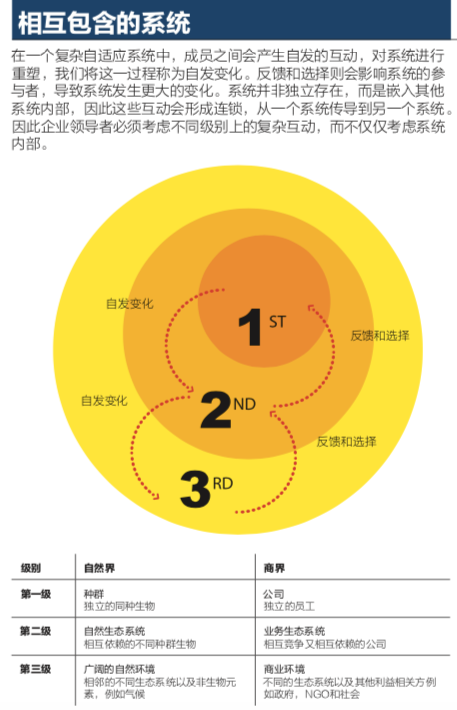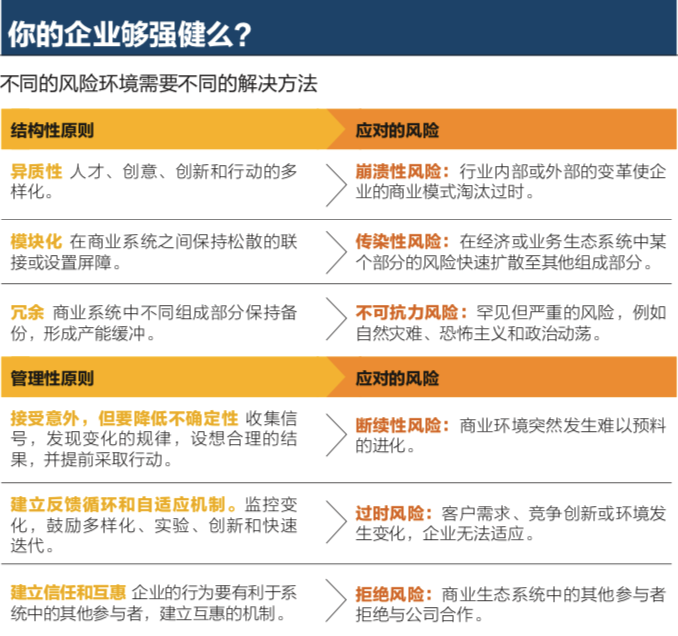Even when pursuing the maximization of their own interests, the enterprise must guarantee to provide value to the entire system.
Editor’s note: This article comes from the WeChat public account “Harvard Business Review” (ID: hbrchinese).
The entire population of organisms is a complex adaptive system. This system is embedded in a broader ecosystem, and the ecosystem is embedded in a broader biological environment.
A company is a complex adaptive system, which is embedded in a broader business ecosystem and the system is embedded in a broader social environment.
What do these findings mean for company leaders?
First, they need to be more pragmatic about what they can predict and control: what transactions they can influence through collaboration, and which ones are not under control. In particular, they must be prepared: those unpredictable and even extreme spontaneous events may have a chain reaction through the bottom of the organization. The financial crisis of 2007-2008 is a typical example. The risk of subprime loans in the US real estate market has evolved into a financial disaster that has swept the global financial markets.
Second, they must go beyond the scope of their company’s inclusion and control, and monitor and respond to external complexity. The company CEO must ensure that the company makes a positive contribution to the entire system while obtaining sufficient benefits from the system. Companies that cannot create value for stakeholders in external systems will be marginalized. Similarly, if a business ecosystem cannot provide benefits to internal members, it will eventually betrayed.
Third, leaders must face a helpless reality: Participants who try to directly control the bottom of the system often have counterproductive consequences at the upper level of the system, such as strategic obstruction or even the collapse of the ecosystem. They must abandon the simple causal logic model and stop trying to directly control individual participants. Instead, they should shape the surrounding environment of the participants and thus affect their behavior. For example, in shaping collective behavior, it is more effective to promote collaboration, expand authority, and mobilize employee enthusiasm through questions and simple rules than from top to bottom.
1. Maintain heterogeneity
The diversity of participants in a complex adaptive system allows the system to adapt to a changing environment. From a broader perspective, diversity is a prerequisite for adaptive evolution.
In a business environment, leaders must ensure that the company maintains sufficient diversity on three levels: talent, innovation, and activity. Cultivating diversity may lead to a reduction in short-term efficiency, but it is essential to the robustness of the system. To promote diversity, a relatively simple method is to hire employees with different personalities, educational levels, backgrounds, and work styles. However, even if the company’s employee diversity is high, employees are sometimes reluctant to challenge the existing mainstream business logic, especially in those successful companies. A clear cultural transformation and active management support, even encouraging them to make mistakes, can help employees innovate.
In fact, no error means that the company has lost a lot of opportunities, which ultimately leads to increased vulnerability of the company. Many Silicon Valley companies welcome meaningful, “learning” failures. They believe that success cannot be separated from the contributions of these failures.
Fujifilm shows how to make the company stronger by strategically maintaining heterogeneity. In the late 1990s, digital imaging technology entered the consumer market and quickly swallowed the market demand for imaging film, and the entire film industry was also in crisis. Unlike the approach of Kodak, another giant in the film industry, Fuji not only explored new businesses in closely related industries, but also entered new business areas, such as pharmaceuticals and cosmetics.
These explorations did not simply stop, but reached a sufficient depth. The company’s diversified exploration has paid off: The film market reached its peak in 2000, and its size shrank by 90% in the next 10 years. However, during this period, Fuji’s performance did not decline but rose. In contrast, the old rival Kodak declared bankruptcy in 2012.
2. Keep modular
The components of the modular and complex adaptive system are loosely connected. A highly modular system can prevent risks from spreading among the various components, making the entire system more robust.
In a business environment, modularity also requires trade-offs. Completely isolating external risks means giving up the benefits brought by a high degree of connectivity. In a company, the close connection between different businesses or regions can promote information flow, innovation and corporate flexibility; but it also exposes the company to serious risksTime is more fragile. In a broader ecosystem, close connection with other stakeholders will also bring similar efficiency improvements, and of course interdependence will also create risks. Because the reduction in risk is subtle and invisible, and the improvement in efficiency is immediate, managers often overemphasize the benefits of the latter.
Apart from these trade-offs, modularity is still very important to the robustness of the system (Robustness, which refers to the control system maintaining certain other performance characteristics under certain parameter perturbations). If the company ignores it for short-term benefits, long-term risks may follow.
3. Retain redundancy
In redundant systems, multiple parts play the same role. When one of them fails, the other parts can accomplish the same function. In a rapidly changing environment, where risk events occur more frequently, redundancy becomes particularly important.
Imagine how the human immune system uses redundancy to fight disease. The body has multiple lines of defense against pathogens, including physical barriers (skin and mucous membranes), internal immune system (white blood cells) and adaptive immune system (antibodies). Each line of defense has multiple cellular and molecular defense mechanisms. In a healthy human body, these redundant mechanisms cooperate with each other, and when one of the lines of defense fails, the other mechanisms block the infection of the pathogen.
However, companies often avoid redundancy, they regard it as the enemy of lean and efficiency. This has led to some catastrophic consequences. In the 1990s, Ericsson was one of the world’s leading mobile phone manufacturers. It uses a single source strategy to purchase key components for mobile phones. In 2000, a fire broke down Philips’ microchip manufacturing plant. Ericsson could not find an alternative supplier in a short period of time, and had to stop production for several months. In that year, the mobile phone department announced a loss of up to 1.7 billion US dollars, which eventually led to the acquisition of this department by Sony.
How can enterprises achieve low cost, high efficiency and redundancy? First, managers need to identify the stakeholders that companies rely on most. They may be suppliers or new innovative partners. For Ericsson, this stakeholder is Philips. Managers should calculate the feasibility of establishing redundancy to reduce risks. Usually companies need to develop new partners and carefully weigh the pros and cons.
4. Reduce uncertainty
A key feature of complex adaptive systems is that we cannot accurately predict their future state. However, we can collect signals and judge the changing patterns and set



